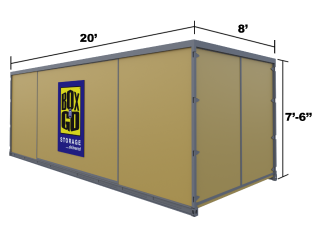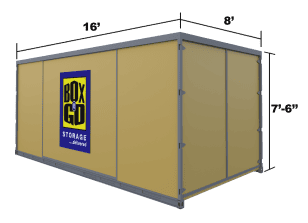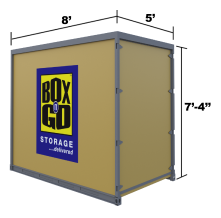


REVIEWS
RATING
GUARANTEE
Store on your driveway or inside our secure facility. Load/unload only once. Ground level access.


20’ Container – all weather.
Perfect for 3-bedroom residence.
5-7 rooms, furniture, appliances, etc.

16’ Container – all weather.
Perfect for 2-bedroom residence.
3-5 rooms, furniture, appliances, etc.

8’ Container – all weather.
Modular – works for any need.
Each fits 1-1.5 rooms.



- No truck to rent. We deliver storage to you!
- Load/Unload only once.
- Pay only for space you use.
- Secure, climate-friendly facility.
- Drive-up access
- Save money and time.
- Reduce the risk of accidents and injuries.
- No need to pay for gas, insurance & mileage!
- You only need to load your belongings once!
- No need to load and unload it all again into a storage unit.
- All containers come with easy ground level access!
(if storing at our facility)
- No not need to guess on how much space you actually need.
- Order an extra 8’ x 5’ unit. Do not use it – do not pay for it.
- Highest degree of security and protection.
- Our 8’ x 5’ units are breatheable – no mold or mildew.
- No funky smell when your belongings return.
(if storing at our facility)
- Access your units at ground level.
- No elevators, ramps, stairs to climb.
- Schedule access appointment & drive straight to your units.

How To Pack Specific Household Items
The following are some valuable tips that can help you with packing and storing some specific items that you may have in your household. These tips are provided for your reference and cover many household items regardless of whether they would be stored inside the Box-n-Go storage containers or elswhere:
Tables: Take the legs off tables when possible and wrap the legs separately. This prevents possible damage and also saves space. Place any hardware in a plastic bag and tape it to the underside of the table, so you will not misplace it. Wrap the tabletop with cloth or paper pads and place against the side of the container, not on the bottom. If a table will not disassemble, place padding on the floor and place the table on its top with the legs pointing up.
Dishes and Glassware: Place a layer of packing inside the bottom and at the top of boxes containing glassware. All glass items should be individually wrapped. Nest cups and bowls and stand plates and saucers and platters on edge. Consider using potholders and dishtowels to cushion the bottom and sides of your boxes. Wrapped glasses should be placed near the top of cartons. Fine silver should be wrapped in cloth or silver paper. Fill all pockets with packing. Always make sure you have plenty of cushioning below and above all your glassware. For greater protection, consider purchasing “dish packs.” Make sure your boxes are firmly packed so they will not be crushed. Label boxes containing glassware “FRAGILE – THIS SIDE UP” and do not place heavy items on top of boxes with glassware.
Flat China & Flat Glassware: Larger china and glass plates, platters and other flat pieces are excellent as the lowest layer in a dish pack. Place cushioning material in the bottom of a carton. Wrap each piece individually with clean paper, then wrap up to three in a bundle with a double layer of newsprint. Place these bundled items in the carton in a row on edge. Surround each bundle with crushed paper, being careful to leave no voids or unfilled spaces. Add two or three inches of wadded paper on top of the bundle to protect rims and make a level base for the next tier. Horizontal cardboard dividers can be helpful in keeping layers level. Smaller plates, saucers and shallow bowls could make up a second layer. Wrap and pack in the same way as larger items. Label boxes containing glassware “FRAGILE – THIS SIDE UP” and do not place heavy items on top of boxes with glassware.
Bowls and Odd-shaped Items: Depending on their weight, these might be used for either the bottom or middle layers. Wrap the same way as flat plates. Stand shallow bowls (soup plates, etc.) on edge in the carton and deeper ones (such as mixing bowls) nested two or three together, upside down on their rims. Wrap sugar bowl lids in newsprint, turning them upside down on top of bowls. Then, wrap both together in newsprint, followed by a double outer layer. Wrap sugar bowls, cream pitchers, sauce containers, gravy boats and similar pieces in newsprint and then a double outer wrapping. Place all upright in the carton, then top off the layer with wadded newsprint. Label boxes “FRAGILE – THIS SIDE UP” and do not place heavy items on top.
Cups: Even when using a dish pack and cellular dividers, wrap china cups individually first, protecting handles with an extra layer of clean paper. Then, pack cups upside down. If not using cellular dividers, wrap cups individually first in a double layer of paper and place them upside down on rims in a row on an upper layer with all handles facing the same direction. Top off the layer with wadded newsprint. Label boxes “FRAGILE – THIS SIDE UP” and do not place heavy items on top.
Silver & Flatware: To protect silver pieces from tarnishing, they should be completely enclosed in newsprint or plastic wrap. Hollow ware, including bowls, tea sets and serving dishes should be wrapped carefully like fragile items and packed like china. Loose flatware may be wrapped individually or in sets, and in paper, clear plastic bags or small gift boxes that are then secured with tape. Even if silverware is in a chest, consider wrapping the pieces individually and repositioning them in the chest. Or, fill all voids in the chest with newsprint to prevent shifting. The chest can be wrapped in a large bath towel.
Furniture: Shrink-wrap large, upholstered items Place a cardboard mat or plastic sheet on the floor and stand mattresses on end. You may want to consider packing couch pillows in large boxes. Disassemble beds (if the item can be disassembled, it will save on the cost). Most lightweight chairs should be stacked seat-to-seat or placed upside down on tables. Table corners can be protected with cardboard. Make sure that all drawers and shelves are completely closed and taped shut. Try to cover furniture to protect from minor scratches. Particleboard furniture is not very sturdy, and cannot handle the weight at times. Invert light chairs so they are “seat-to-seat.” There usually is space between the legs for small, lightweight items. Finally, place a light dust cover over your furniture.
Piano: A professional piano service provider should take care of the preparations for packing and storing a grand or baby grand piano. Upright (spinet, console and studio) pianos usually do not require preparation in advance. All pianos should be pad-wrapped to protect the surface. Plan to have your piano tuned after storage.
Pool Table: Disassembly and crating of your pool table should be provided by a third-party service. If possible, contact the store where the pool table was purchased to obtain assistance. You will need to make arrangements to have the pool table uncrated, reassembled and leveled.
Glass Table Tops, Marble Slabs, Large Mirrors, Paintings, Statues & Large Vases: It’s best to consider custom-made cartons and crates for items of this kind. Paper should never be permitted to touch the surface of an oil painting.
Figurines and Other Delicate Items: Be sure the items are well-protected with plenty of cushioning. Wrap first in tissue paper, paper towels or facial tissue. Then, wrap carefully in paper that has been wadded and flattened out. Small mirrors, plaques and pictures should be wrapped individually in tissue paper with an outer layer of newsprint. A bath towel or small blanket makes an excellent outer wrapping and padding for glass. Place items on edge in a carton.
Upholstered items: Couches can be packed on their feet, with a second couch inverted on top of the other for protection. A small single couch or a love seat can be placed on end, using paper pads to protect the armrests.
Mattresses & Pillows: Place mattresses and box springs in a protective bag or even old mattress covers to keep them clean during moving and storage, and place along the side of the container. Pillows may be placed in bureau drawers or packed in cartons. They also make good padding for other items.
Lamps: Remove all bulbs and shades from lamps. Place small bases in dresser drawers with paper or cloth padding, and large ones in boxes with wadded-up paper in the extra space. Shades should be placed in individual boxes with wadded-up paper in the empty spaces. Often you can “nest” several lampshades together. Use a special box for all of these shades, rather than packing them with other items. Pack delicate lampshades separately. Do not use newsprint to wrap lampshades or any other goods that may be damaged by ink stains. Do not store heavy items on cartons containing lamps or lampshades. Pack in sturdy cartons labeled “fragile”. Label cartons “LAMP SHADES – FRAGILE – TOP LOAD ONLY.”
Chandeliers and Leaded Glass Shades: It is best to professionally crate large leaded or other glass lampshades or chandeliers.
Silk or Artificial Flowers: An arrangement of artificial flowers should be packed in a separate carton. Wrap carefully in plastic wrap, tissue paper or paper towels. If possible, fasten the base of the floral piece to the bottom of the carton to prevent shifting. Label the carton “FRAGILE – THIS SIDE UP”.
Bed Frames and Futons: Tie bed rails together. The frame should be broken down (disassemble it as it was, when you purchased it, this will save on additional costs). Store in such a way so that the frames would not damage any adjacent items during the transit and storage, fold the mattress in half and tape it, wrap the mattress in plastic to assure it is completely protected.
Bedding, Curtains, Drapes and Linens: Curtains and drapes should be stored on hangers. If hanging cartons are not available, such items should be carefully folded and stored in dresser drawers or cedar chests along with bedding and linens, blankets, pillows, sheets and the like. Blankets, sheets, tablecloths, towels, pillowcases and other linens may be protected by a large plastic bag and packed in a carton that has been lined with clean paper. Wrap your most prized possessions in tissue. Also, linens and bedding are good for cushioning or padding many other items. Food crumbs or stains should be removed before storage and avoid storing anything that will attract rodents. If you decide to wash your linens before you pack them, make sure they are thoroughly dried first.
Clothing: It’s best to hang clothing whenever possible. This is why the wardrobe boxes are best for storing clothing. One will hold about two feet of compressed clothing on hangers; figure more cartons if wrinkles are a concern. You can place shoes and folded items in the bottom and use the metal bar to hang others on the top. Small garment items can be left in dresser drawers. If wardrobe cartons are not used, each garment should be removed from its hanger, folded and placed in a suitcase or a carton lined with clean paper. Hats may be left in hatboxes and placed in large cartons, or stuff the crown of each hat with crumpled tissue paper, wrap tissue loosely around the outside and place in a carton lined with clean paper, with the heavier hats at the bottom. Don’t pack anything else with hats. Label the carton “FRAGILE”.
Jewelry: Valuables such as fine jewelry should be removed from drawers and never packed with your household goods. They will be most secure if they remain in your possession. If you have an extensive high-value collection, consider a third party service that specializes in storing or transporting jewelry.
Toiletries: Dispose of aerosol spray cans, such as hairspray or deodorant, open bottles and other prohibited items. These cannot be packed for storage and moving. Please see the listing of prohibited items for further details. Any toiletry items that are allowed should be carefully taped shut and wrapped to prevent leakage, then packed in small cartons.
Mirrors and Pictures: It’s best if you can crate them, or at least wrap mirrors and pictures in paper, bubble wrap and heavy cardboard, then bind with tape and pack in a mirror packing box. Most pictures and mirrors can be wrapped and packed in telescoping mirror cartons. Wrap each wall hanging individually with bubble wrap, blankets, or towels. Pack flat items on their edges. DO NOT lay mirror boxes flat! If possible, place between a mattress and box spring, or place on the side of your container. Fragile or valuable fine art may require special professional crating. We advise against packing such items for storage or moving inside the containers.
Chest of Drawers: Take advantage of drawers for packing many light household items such as photos and clocks. Many small fragile items can be stored safely in your dresser drawers, however be sure to use towels or other packing materials to make sure that the fragile items will not shift during the move.
Rugs: Vacuum rugs, sprinkle with moth flakes, roll up and tie with rope. Rugs can be wrapped with paper pads for additional protection. Area rugs should be loaded last and unloaded first.
Computers and Computer Equipment: If possible use your original boxes to store these items. When using other than original boxes make sure to tightly secure all contents. Disconnect and mark all wires and cables for easy assembly. Detach paper holders/feeders from printers and wrap monitors and additional hardware as you would other home electronics. Remove toner and ink cartridges. Back up your entire computer file system on DVDs or other file storage disks/devices. Cover monitor screen with a sheet of bubble-wrap. We also suggest filling the box with towels and bedding to make sure the items are not loose. Also label the outside of the box “fragile” so that everyone is aware of that. In most cases monitors fit in the medium size (3.0 cubic ft) box. Use some of your towels, sweatshirts (soft goods) to pack around them. Most printers can fit into a small size (1.5 cubic ft) box. You may also put some of your school supplies in that box as well.
TIP: Place small colored stickers on each cord and the same color sticker where the cord connects to the device and pack them in the same box as the equipment they belong to.
Stereo Equipment: If possible use your original boxes to store these items. When using other than original boxes make sure to tightly secure all contents. We recommend that DVDs be put into a box (either a medium, 3.0 cubic ft, or a large, 4.5 cubic ft box). If you have more than one of these items make sure that some form of cushion is used between them. Advance preparation is required for compact disc players, digital videodisc players and stereo turntables. On compact and digital videodisc players, secure the laser with transport screws located on the bottom or back of the unit. Most turntables have a plastic lock, which should be used to hold the tone arm in place. For additional protection, you may tie a piece of string around the arm in case the lock does not hold. Also, secure the platter (where the records are placed) by tightening the appropriate screws. These are usually located on top of the turntable, but check you owner’s manual if in doubt.
TIP: If it’s not feasible to pack your remote controls in the same carton with their corresponding units, consider packing all remotes in a separate box, clearly labeled.
Speakers: Pack speakers in well-cushioned dish packs.
Television Sets: Call your local cable company to request your service discontinued. If you have a converter box, return the box and keep the receipt for future reference. Smaller TV’s (e.g.13″) should go into a medium size (3.0 cubic ft) box along with soft goods to cushion (secure) it. An issue with 13″ TV’s is that they are an odd shaped item, so putting into a box along with other items is recommended The larger TV’s (16″ and larger) can be stored as is. We recommend that the power cord be taped up (on the back of the TV and perhaps a sheet of bubble wrap to protect the glass monitor). Some large and plasma television sets may need to be crated by a professional.
Satellite Dish: Contact an electrician or technician from a satellite dish distributorship for the disconnection and disassembly of this sensitive equipment. Depending upon the construction and size of the unit, it may need to be professionally crated.
CDs, DVDs, Tapes and Records: Stand compact discs and records on edge, never flat, on a layer of crushed paper. Support at both ends with large, hardcover books or several pieces of cardboard cut to fit. Top with another layer of crushed paper. Identify contents on the outside of the box and mark, “FRAGILE”. Cassette tapes should be placed in their cases and wrapped individually in crumpled paper. Place individual tapes either vertically or horizontally on a couple of layers of crushed paper. If records are not in jackets, wrap individually in tissue paper or plastic wrap to protect from scratches. Records are heavy and therefore should be packed in small cartons.
Office Furniture: Any modular office furniture will need to be dismantled and disassembled for packing. Use tape to mark where pieces go together and keep the hardware together (including drawer pulls) in one spot, like a plastic bag or coffee can.
Books and Documents: Pack books of the same general size together, in small book cartons for easy lifting. Pack them either flat, or with the spine touching the bottom of the carton. Do not pack with spine facing upward, as glue can break away from the binder. Do not place boxes directly on concrete floors, but use pallets or skids to prevent moisture absorption. Use packing to fill out empty pockets in the boxes. Do not pack fragile items in the same box with books and do not overload. These boxes will get heavy quickly so remember to use your legs when lifting. Do not pack boxes heavier than 50 pounds. Expensively bound volumes or those of sentimental value should be individually wrapped before packing. We advise against packing such items for storage or moving inside the containers.
Photographs: Family photographs, videos, slides and negatives should be packed in separate cartons rather than being combined with other household items. Protect framed photos with padding and cushioning, standing them on edge in a carton. Label cartons for easy identification. We advise against packing such items for storage or moving inside the containers.
TV Stand/ Stereo Cabinet: Remove glass doors if possible and pack in a mirror carton.
Large Appliances: Please take the right steps to protect your investments. Appliances may be some of the most expensive items you own. In preparing your appliances for packing and storage, it is important that they be clean and dry to avoid the build up of mildew and mold. If possible, use your original boxes. Otherwise, wrap each item separately and securely. Here’s your guide to pack smart and simply.
TIP: Remember to turn off and unplug any appliances before you start preparing and cleaning them for packing.
Dishwasher: Clean and dry it thoroughly at least 24 hours before packing. Disconnect and drain the hoses. Leave the door open for a while prior to the move. Wrap dry hoses in towels and packing paper and place inside the dishwasher. Consider using empty space in your appliances to move lightweight or crushable items with proper padding. Boxes can be stacked on top.
Stove Top/Range/Oven: Clean each thoroughly. Grease left on a stovetop will catch dust and dirt, and unfortunately, leave spots on anything that it touches. Remove broiler pan and racks from your oven. Tape burners or coil elements to the top of your stove and tape down all knobs. Detach all removable parts and pack safely in a box, clearly marked with the contents. If you are moving a gas range, it must be disconnected prior to packing by a qualified person. The gas line must be properly secured also. Tape electrical cords to the appliance and tape all doors and lids closed.
Washing Machine: Clean and dry it thoroughly at least 24 hours prior to packing. Disconnect and drain the hoses. Wrap metal connector ends of hoses in a towel and place inside the washer. Secure the tub following the manufacturer’s guidelines to prevent swaying with a brace or by placing towels between the tub and sidewall. Note: If you don’t have the manufacturer’s guidelines, you can purchase a washer kit with a manual that provides instructions on how to secure the tub by tightening down the tub using screws. If you prefer not to do it yourself, there are many third party service providers. Tape electrical cords to the appliance and tape all doors and lids closed. Consider using empty space in your appliances to move lightweight or crushable items with proper padding. Boxes can be stacked on top.
Clothes Dryer: Before cleaning, unplug or turn off the dryer from electrical power. Clean the lint screen. Prior to plugging in your electric dryer at your new residence, have your power supply checked for the correct electrical requirements. If you are moving a gas dryer, the appliance should be disconnected and the gas line capped off by a qualified person. Tape electrical cords to the appliance and tape all doors and lids closed. Consider using empty space in your appliances to move lightweight or crushable items with proper padding. Boxes can be stacked on top.
Refrigerator/Freezer: Unplug the fridge at least 48 hours before packing. Dry out refrigerators and freezers, especially those that contain an icemaker. Dispose of all perishables. Unplug the power cord and wash and dry all removable parts thoroughly. Allow the parts, including the interior of the refrigerator and freezer, to dry thoroughly to allow all moisture to evaporate. Pack all loose parts including bins and shelves in a secured, approved container. Vacuum the condenser or compressor. Empty and clean the evaporator pan; allow time for it to dry. Turn off the water and disconnect the water line, if you have a cold water dispenser or automatic icemaker. Empty the water reservoir. If your refrigerator or freezer is an older model, you may have to have the compressor or motor bolted down. Place a spacer between the door and tape shut. The spacer will allow air to circulate so that it does not smell when you get it back. The power cord should be stuffed in the bottom of the fridge so the cord is not dragging behind. Make sure your fridge does not have any fluid dripping from it. Consider using empty space in your appliances to move lightweight or crushable items with proper padding.
TIP: There are desiccants available that may help keep your refrigerator dry and mildew free while in storage and transit. Check your local hardware store for more information.
TIP: Once you receive your refrigerator back form storage or after moving, allow 24 hours prior to operating the unit. This will allow the time for the oil to settle, preventing the possible damage to the compressor. After the unit is placed back in operation and your icemaker is in service, dispose of the first few batches of ice to clear out any impurities from opening the water line.
Microwave Oven: Remove any glass trays, wrap and securely pack them in a carton. The microwave can either be placed in its original box, if available and still in good shape, or a well-cushioned carton. Do not place cardboard in the door opening because it can spring the door during transit. We recommend that you tape down the glass turntable, tape it shut, tape the power cord on the back of the unit.
Small Appliances: In preparing your appliances for packing and storage, it is important that they be clean and dry to avoid the build up of mildew and mold and do not attract rodents. Items such as clocks, small radios and other small appliances should be wrapped individually and packed in a carton cushioned with crushed paper. If their cords disconnect, wrap them in plastic and secure them to the appliance they belong to. Make sure cords are wrapped so as not to scratch or damage items. Steam irons should be emptied of all water, wrapped and placed in the cushioned bottom of a box.
TIP: Remember to turn off and unplug any appliances before you start preparing and cleaning them for packing.
Food Items: Use or dispose of all perishables. You will also need to get rid of cleaning products and other kitchen chemicals. See our listing of prohibited items for further details. Boxed or canned goods should be packed in small boxes. Dispose of any open packages and wrap glass jars to prevent breakage.
Pots & Pans: Pots, pans and similar items should be wrapped and packed in medium size cartons. Depending on their weight, these might be used for either the bottom or middle layers.
Tools: Long-handled garden tools, as well as brooms and mops, should be cleaned, oiled, bundled and tied together securely. Attachments should be removed from power tools and packed separately.
Hand tools may be left in tool boxes and the spaces filled with crushed paper, or they may be packed according to general packing rules. Always use small cartons for heavy tools.
Use old towels to wrap and tape any sharp-edged tools.
Don’t put too many heavy tools in one box, since it may be heavier than you expected. It’s a good idea to wipe your tools with a slightly oily rag to prevent rusting if you are storing your belongings in non-climate friendly storage.
Holiday Decorations: Save the original cartons that contained delicate ornaments and pad the ornaments with packing paper or newsprint. Wrap strings of lights around a piece of cardboard before placing in a carton lined with packing paper.
Bicycles and Other Metal Items: To retard rust, wipe all metal surfaces with a rag containing a few drops of machine oil. Clean and cover with a paper pad or moving blankets to protect your other goods from being torn.
Lawn & Patio Furniture: Remove cushions and clean frames. Pack cushions in large carton or wardrobe. Keep umbrella clean and dry during transport by wrapping it in paper padding or a plastic bag and taping shut. Do not pack the weighted umbrella stand.
Grill: Dispose of any unused charcoal. Remove tank (it cannot be packed for moving and storage) and properly purge hose. See the list of prohibited items. Secure lid and immobilize moving parts.
Outdoor Equipment: Dismantle children’s swing sets, TV antennas and garden sheds you plan to pack for storage and moving.
- Place small hardware in a plastic bag or old coffee can and label.
- If the parts bag can be securely attached to corresponding equipment, all the better.
- Drain all gasoline and oil from lawn mowers, weed eaters, chain saws and other equipment.
- Disconnect all batteries.
Pots and Planters: Pack small ceramic or pottery planters like any fragile item – individually wrapped with plenty of cushioning.
Trash Cans: Clean cans if you plan to pack them into the storage container. If your cans are sealable or rollable, you may pack items in them, just don’t make them too heavy.

